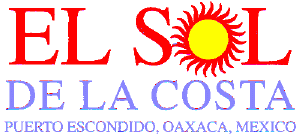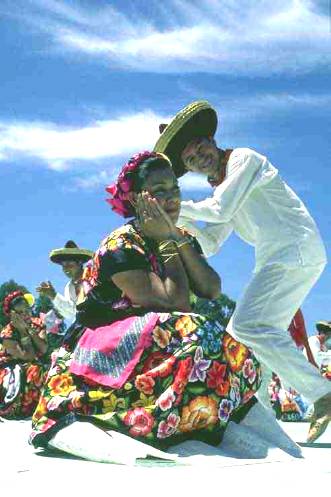

 It brings together the indigenous cultures from all the regions of
Oaxaca to proudly display their unique traditions through music and
dance, song and ceremony.
It brings together the indigenous cultures from all the regions of
Oaxaca to proudly display their unique traditions through music and
dance, song and ceremony.
The city is always an interesting cradle of cultures, but during Lunes del Cerro the city is positively vibrating with sights, sounds, smells and excitement. The Zócalo is crammed with arts and crafts, food stalls are everywhere and parades of fabulously bedecked participants seem to take place constantly.
A Zapotec word signifying offering, Guelaguetza was the term used to describe the Oaxacan ceremony and celebration held each year to appease the gods in return for sufficient rain and a bountiful harvest.
This offering of life's gifts took place midway through the rainy season, when it was essential that the rains continue moderately and without excess to bring forth the best crops. The feast of Xilonen, goddess of tender corn, falls in this period on what in the modern calendar is July 16 and is the signal to begin the two weeks of celebration.
When the Spanish arrived in Oaxaca in 1521 they imposed the Catholic religion on the indigenous people. One of their tactics was to "convert" to Catholic ways the deeply rooted customs honoring pagan beliefs. For example, razing temples and building churches on the ruins, conserving the holiness of the place but identifying it with the new religion. In the case of the Guelaguetza, the idea was to change it to a celebration of the feast on July 16 of the Virgin of Carmel and that is why the Guelaguetza begins with the traditional calenda parades from the church of Carmen Alto.
 The festival endured through Colonial and pre-Revolutionary times. Then
in 1932, as part of the celebration of the 400th anniversary of the
founding of the city of Oaxaca, groups from all the regions of the state
paid homage to their capital with a great festival of dance, music and
presentation of their particular traditions. It was held on the hill
overlooking the city now known as the Cerro del Fortín, from the
location of Aztec garrisons there in the 15th century. It was always a
very popular place for outings and probably an important ceremonial
site.
The festival endured through Colonial and pre-Revolutionary times. Then
in 1932, as part of the celebration of the 400th anniversary of the
founding of the city of Oaxaca, groups from all the regions of the state
paid homage to their capital with a great festival of dance, music and
presentation of their particular traditions. It was held on the hill
overlooking the city now known as the Cerro del Fortín, from the
location of Aztec garrisons there in the 15th century. It was always a
very popular place for outings and probably an important ceremonial
site.
In 1974 a special auditorium was opened on the Cerro to seat 11,400 spectators to accommodate the performances. Mondays on the Hill this year are July 19 and 26. Tickets sell out fast, but there are a multitude of other activities that take place in the city, many of which are free.
Among these are the contest to elect the Diosa Centeotl (Corn Goddess)
from among the different regional delegations to the Guelaguetza. There
are fairs and expos, concerts, theater and dance in different parts of
the city especially in Jardin el Pañuelito, on the Andador Turistico
(Macedoneo Alcalá), at the Zocalo, in the atrium of the Santo Domingo
church and the Plaza de la Danza.
guelaguetza-oax.com